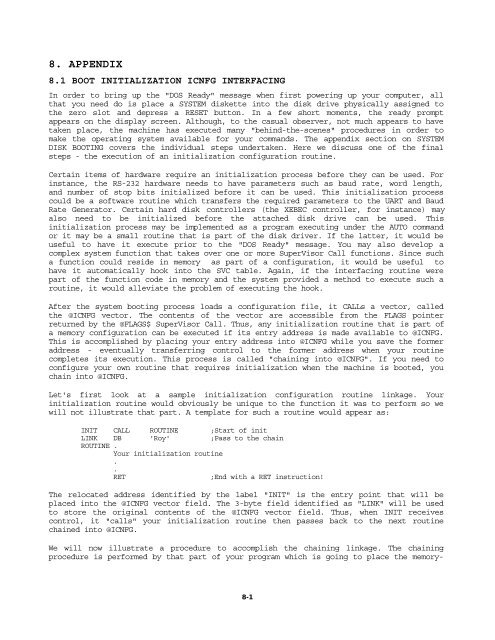The Programmer's Guide to TRSDOS Version 6 - Tim Mann's Home ...
The Programmer's Guide to TRSDOS Version 6 - Tim Mann's Home ...
The Programmer's Guide to TRSDOS Version 6 - Tim Mann's Home ...
Create successful ePaper yourself
Turn your PDF publications into a flip-book with our unique Google optimized e-Paper software.
8. APPENDIX<br />
8.1 BOOT INITIALIZATION ICNFG INTERFACING<br />
In order <strong>to</strong> bring up the "DOS Ready" message when first powering up your computer, all<br />
that you need do is place a SYSTEM diskette in<strong>to</strong> the disk drive physically assigned <strong>to</strong><br />
the zero slot and depress a RESET but<strong>to</strong>n. In a few short moments, the ready prompt<br />
appears on the display screen. Although, <strong>to</strong> the casual observer, not much appears <strong>to</strong> have<br />
taken place, the machine has executed many "behind-the-scenes" procedures in order <strong>to</strong><br />
make the operating system available for your commands. <strong>The</strong> appendix section on SYSTEM<br />
DISK BOOTING covers the individual steps undertaken. Here we discuss one of the final<br />
steps - the execution of an initialization configuration routine.<br />
Certain items of hardware require an initialization process before they can be used. For<br />
instance, the RS-232 hardware needs <strong>to</strong> have parameters such as baud rate, word length,<br />
and number of s<strong>to</strong>p bits initialized before it can be used. This initialization process<br />
could be a software routine which transfers the required parameters <strong>to</strong> the UART and Baud<br />
Rate Genera<strong>to</strong>r. Certain hard disk controllers (the XEBEC controller, for instance) may<br />
also need <strong>to</strong> be initialized before the attached disk drive can be used. This<br />
initialization process may be implemented as a program executing under the AUTO command<br />
or it may be a small routine that is part of the disk driver. If the latter, it would be<br />
useful <strong>to</strong> have it execute prior <strong>to</strong> the "DOS Ready" message. You may also develop a<br />
complex system function that takes over one or more SuperVisor Call functions. Since such<br />
a function could reside in memory as part of a configuration, it would be useful <strong>to</strong><br />
have it au<strong>to</strong>matically hook in<strong>to</strong> the SVC table. Again, if the interfacing routine were<br />
part of the function code in memory and the system provided a method <strong>to</strong> execute such a<br />
routine, it would alleviate the problem of executing the hook.<br />
After the system booting process loads a configuration file, it CALLs a vec<strong>to</strong>r, called<br />
the @ICNFG vec<strong>to</strong>r. <strong>The</strong> contents of the vec<strong>to</strong>r are accessible from the FLAGS pointer<br />
returned by the @FLAGS$ SuperVisor Call. Thus, any initialization routine that is part of<br />
a memory configuration can be executed if its entry address is made available <strong>to</strong> @ICNFG.<br />
This is accomplished by placing your entry address in<strong>to</strong> @ICNFG while you save the former<br />
address - eventually transferring control <strong>to</strong> the former address when your routine<br />
completes its execution. This process is called "chaining in<strong>to</strong> @ICNFG". If you need <strong>to</strong><br />
configure your own routine that requires initialization when the machine is booted, you<br />
chain in<strong>to</strong> @ICNFG.<br />
Let's first look at a sample initialization configuration routine linkage. Your<br />
initialization routine would obviously be unique <strong>to</strong> the function it was <strong>to</strong> perform so we<br />
will not illustrate that part. A template for such a routine would appear as:<br />
INIT CALL ROUTINE ;Start of init<br />
LINK DB 'Roy' ;Pass <strong>to</strong> the chain<br />
ROUTINE .<br />
Your initialization routine<br />
.<br />
.<br />
RET ;End with a RET instruction!<br />
<strong>The</strong> relocated address identified by the label "INIT" is the entry point that will be<br />
placed in<strong>to</strong> the @ICNFG vec<strong>to</strong>r field. <strong>The</strong> 3-byte field identified as "LINK" will be used<br />
<strong>to</strong> s<strong>to</strong>re the original contents of the @ICNFG vec<strong>to</strong>r field. Thus, when INIT receives<br />
control, it "calls" your initialization routine then passes back <strong>to</strong> the next routine<br />
chained in<strong>to</strong> @ICNFG.<br />
We will now illustrate a procedure <strong>to</strong> accomplish the chaining linkage. <strong>The</strong> chaining<br />
procedure is performed by that part of your program which is going <strong>to</strong> place the memory-<br />
8-1















